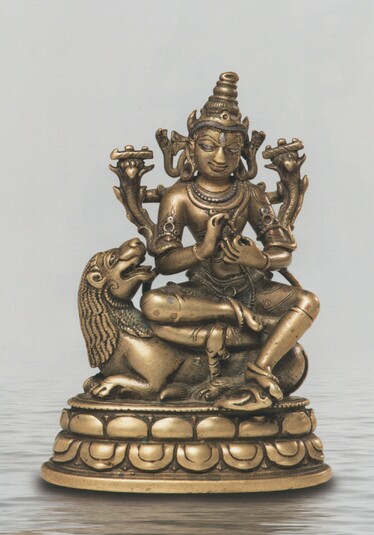
Item: Manjushri (Bodhisattva & Buddhist Deity) - Vadisimha
| Origin Location | India |
|---|---|
| Date Range | 1100 - 1199 |
| Lineages | Buddhist |
| Material | Metal |
| Collection | Private |
Classification: Deity
Manjushri, Vadisimha or Vadiraja (Glorious Gentle, Lion’s Roar). The exact identity of this form of Manjushri has not yet been textually established. It is unusual for a two armed form of Manjushri to hold two Prajnaparamita books. Typically he holds one book above the left shoulder atop an utpala flower. The White Prajnaparamita described in the Hevajra Tantra typically has two books.
Manjushri appears with one face and two arms. The hands are placed at the heart in a teaching gesture holding the stems of two utpala flowers blossoming at the level of the ears with two folio texts, the Prajnaparamita sutras atop each flower. The hair is piled on top of the head, adorned with a crown, earrings, necklaces, Brahmin’s cord, armlets, bracelets, a jeweled belt and anklets. A thin upper garment is draped over the left shoulder and the lower body is wrapped in a flower patterned garment. In a relaxed posture with the left leg extended and the left drawn up, on a round cushion seat, he rests atop a supine lion with a gaping mouth and head turned upwards, above a simple double lotus base.
Manjushri is the name of one of the most important students of Shakyamuni Buddha according to the Mahayana Sutra Tradition of Buddhism. He is known to exemplify the pursuit of knowledge and wisdom and is typically shown with the attributes of a sword and book. In this sculpture there is no sword and in its place are two books of the Prajnaparamita. The lion is also a common attribute of Manjushri and symbolizes he status as a prince (kumara) having said to be born from a royal family.
The sculpture is identified as North Indian and Pala in style originating from the Gangetic Plain. Objects such as this can be large, medium or small in size. The smaller works were likely intended as personal objects of devotion for a home shrine. They are too small to be considered important for a large temple where they would be lost among the larger works and the many offerings that would be arranged in front by the faithful devotees.
The face is broad with the eyes wide set. The eyes, crown, necklace and flower patterns are inlaid with silver. The lips, ornament details and other flower patterns are of copper inlay. The lips are full and stand out from the use of the copper as contrast. The body is well proportioned and doesn’t give any offence to the eye. This sculpture is a splendid miniature work of Pala aesthetics from a millenia past.
Early forms of Arapachana Manjushri show the book as held in the left hand placed at the heart. Later forms of the figure depict the book above an utpala flower blossoming at the level of the left ear with the stem of the flower held in the left hand again placed at the heart.
Several deities hold the Prajnaparamita book as a principal attribute namely Manjushri and Prajnaparamita. Some forms of Sarasvati can also hold a book. According to Sanskrit and Tibetan literature only Samkshipta Guhyaka Manjushri from the Namasangiti Tantra and Prajnaparamita holds two books, one in each hand above an utpala flower, however this Pala sculpture of Manjushri riding a lion also depicts two books carried above the shoulders.
Konchog Lhundrub edited version of the Bari Gyatsa:
[6] "Vadi Raja Manjushri. [Above] a blue lion with the head looking to the right, in the middle, is a lotus, moon...Vadi Raja Manjushri, with a body colour like melted gold. The two hands are held at the heart performing the Dharma teaching gesture [and] the left holds a blue utpala with a Prajnaparamita book resting upon it. With the same ornaments and garments, seated in the lalitaraja posture. At the front left is Krodha Yama, with a body blue in colour, one face and two hands. The right is held supporting the shin of the Blessed One and the left holds a lasso. With three eyes and bared fangs, yellow hair bristling upwards, the head adorned with a garland of skulls and wearing a lower garment of tiger skin; standing in a manner looking at the face of the Lord."
[7] "Maharaja Manjushri. [Above] a lion, lotus and moon...is Manjushri with a body orange in colour, one face and two hands, seated in the lalitaraja [posture]. The right hand is extended with the palm down on the right knee, the left holds to the heart a blue utpala stem, with the petals blossoming beside the ear, the same ornaments and garments."
Ocean of Sadhanas (Sadhanamala):
"Kalpoktam Vidhini Vadiraja Manjushri....Bhagavan Manjushri, like the colour of gold, adorned with various ornaments, with Akshobhya as a crown, performing the Dharma teaching gesture, the right hand holds the stem of an utpala with the Prajnaparamita book on top, seated in a half posture above a lion, lotus and moon."
The three short texts above are all translated from the standard Tibetan works on iconography.
Jeff Watt 7-2018
Buddhist Deity: Manjushri (Riding a Lion)
Buddhist Deity: Manjushri Main Page
Subject: Deity Figures with Books
Publication: The Art of Buddhist Sculpture (Seer)
Buddhist Deity: Manjushri (Sculpture Masterworks)
Collection of Zhiguan Museum of Fine Art
Collection of Zhiguan (Sculpture)
Buddhist Deity: Manjushri (Indian Sculpture)
Buddhist Deity: Manjushri (Riding a Lion, Sculpture))
